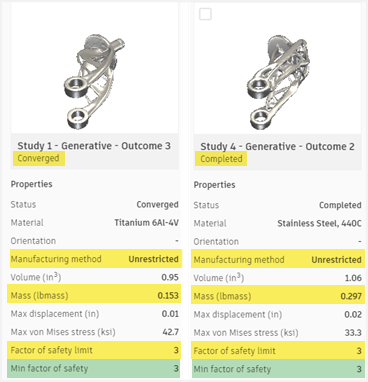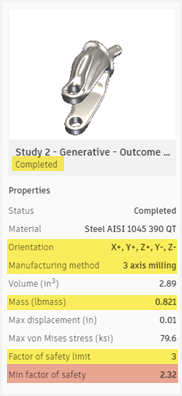Outcome status
The outcome status provides information on what stage the process of generating an outcome has ended and whether the criteria have been met. You can view information about the status of a generated outcome in all views:
- In the Thumbnail View
 and Properties View
and Properties View  - in an outcome thumbnail.
- in an outcome thumbnail. - In the Table View
 - in the Processing status column.
- in the Processing status column. - In the Scatter Plot View
 and Outcome View - in the outcome properties pane.
and Outcome View - in the outcome properties pane. - In the outcome card, which appears when you select an outcome.
The status of a generated outcome can be one of the following:
Converged outcome status
This status is displayed if a convergence limit is met. It is a function of a change in strain energy history, change in the factor of safety, and a change of volume per iteration.
An outcome shows this status if the following criteria are met:
- The objectives are reached during the generation.
- The outcome's minimum factor of safety equals or is greater than the Safety Factor limit.
Completed outcome status
This status is displayed if the solver generated the outcome, but the final outcome iteration does not meet all the criteria specified in the study setup. However, it may still be a valid outcome.
An outcome does not meet all objectives because of one of the following:
- The iteration limit was reached before achieving all objectives (for example the outcome's minimum factor of safety is lower than the Safety Factor limit).
- An error occurred where some geometry regions have separated.
Failed outcome status
This status is displayed if the solver failed to generate any outcome iterations.
Examples
Example 1: Converged and Completed outcome status - Safety Factor limit is met
| Study setup | Outcomes |
|---|---|
| Manufacturing method: Unrestricted Objectives: Minimize Mass Safety Factor limit: 3 |
 |
In this example, the Completed outcome satisfies the Safety Factor limit like the Converged one. The Completed status of Outcome 2 may result from issues like insufficient material strength or excessive loads.
Example 2: Completed outcome status - Safety Factor limit is not met
| Study setup | Outcomes |
|---|---|
| Tool Direction: X+, Y+, Z+, Y-, Z- Manufacturing method: 3 axis milling Objectives: Minimize Mass Safety Factor limit: 3 |
 |
In this example, one of the reasons of the Completed status is the outcome's Min. factor of safety lower than the Safety Factor limit. It looks like the iteration limit was met before achieving the Safety Factor limit. Using this outcome as a starting shape in a next generation may lead to outcomes that work better for your design needs.